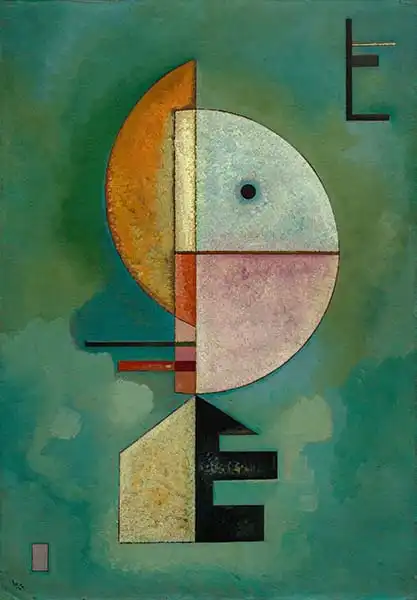About this finishing
Print. The image is printed on the top quality 10-ink HP Z9PS printer on HP matte 270 g / m2 paper. You can choose any size to an accuracy of 1 cm. A margin of 5 cm around the image is added to the size of the motif.


You can find a detailed description about our finishings
here.
In Alto
Date:
1929Medium:
oil on boardDimensions:
70 x 49 Wassily Kandinsky achieves the effect of upward energy by connecting figures together and balancing them along the sides of a continuous vertical line. The geometric shapes and semicircles in this work are arranged into a structure suspended against a rich turquoise and green background. A semicircle sits gracefully on a pointed base, another semicircular shape sliding along a vertical diameter surpasses the larger semicircle and encroaches on the space above. The linear pattern in the upper right corner of the canvas repeats the vertical orientation of the central motif. The configuration resembles the letter E, as a black figure embedded in the base of the central motif. These forms can be understood as purely graphic motifs, or as winking allusions to the initial “Empor,” the original title of the painting.
Kandinsky painted picture In Alto in 1929. Prevailing color of this fine art print is green and its shape is portrait. Original size is 70 x 49. This image is printed on demand - you can choose material, size and finishing.
Wassily Kandinsky (1866-1944). Russian painter and art theorist. One of the most famous painters of the 20th century. He gained fame through his abstract paintings. After the First World War, he moved to Germany, where he worked until 1933, when he fled the Nazis to France. He lived in France until his death. Kandinsky worked a long way to get to his abstract painting technique (he was fascinated by
symbolism and the psychology of colour). Kandinsky’s most famous works belong to the Bauhaus movement - an artistic movement of the 20s and 30s. It is characterized by sharp, geometric shapes (circles, wedges, triangles, etc.), clear colours and thoughtful treatment of surfaces. Perhaps the most famous work of this era is
Yellow - red - blue (1925).


